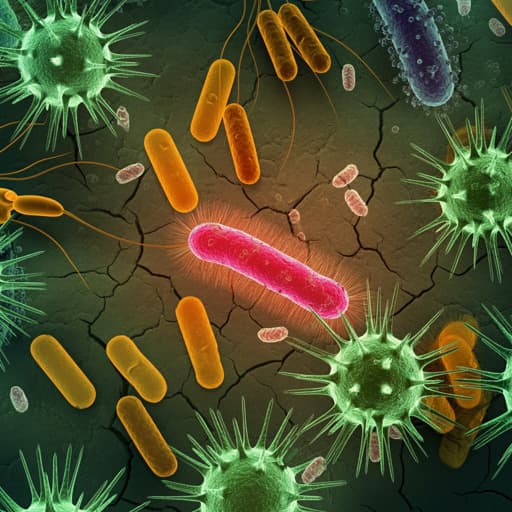
Medicine and Health
The Impact of Earthquakes on Public Health: A Narrative Review of Infectious Diseases in the Post-Disaster Period Aiming to Disaster Risk Reduction
M. Mavrouli, S. Mavroulis, et al.
Discover the post-earthquake challenges to public health as researchers Maria Mavrouli, Spyridon Mavroulis, Efthymios Lekkas, and Athanassios Tsakris delve into the rise of infectious diseases. Uncover the patterns, symptoms, and vital prevention strategies crucial for safeguarding vulnerable populations in disaster-stricken areas.
~3 min • Beginner • English
Introduction
This narrative review examines how earthquakes and their secondary effects (notably landslides and tsunamis) create environmental and social conditions that facilitate the emergence and spread of infectious diseases among affected populations. Although earthquakes account for a smaller share of global disasters compared to floods and storms, they are among the deadliest and most economically disruptive events. Earthquakes generate cascades of impacts (structural collapse, fires, slope failures, tsunamis) leading to casualties, injuries, displacement, and disruption of water, sanitation, health care, and transport systems—factors that heighten infectious disease risks. The study aims to synthesize global evidence of earthquake-associated infectious disease cases, outbreaks, and epidemics, identify pathogens and syndromes involved, delineate risk factors and vulnerable groups, and present prevention and control strategies to inform disaster risk reduction. The review highlights that infectious disease increases have been reported after many earthquakes worldwide, with respiratory, gastrointestinal, vector-borne, and wound/skin infections predominating. It also notes that events of magnitude ≥5.6 with widespread impacts and displacement most often precede such disease burdens and that occurrences cluster along major global fault systems.
Literature Review
The review collates reports of sporadic cases, outbreaks, and epidemics temporally associated with earthquakes and related phenomena (landslides, tsunamis) worldwide, largely spanning 1980–2016. Key thematic areas: (a) Respiratory infections: increases in upper respiratory tract infections and pneumonia in shelters after events in the U.S. (Northridge), Japan (Kobe, Tōhoku), Taiwan (Chi-Chi), Iran (Bam), Pakistan (Kashmir), Indonesia (Sumatra), China (Lushan), the Philippines (Bohol), Nepal (Gorkha), Greece (Cephalonia), and Japan (Kumamoto). Tsunami-related polymicrobial respiratory infections and influenza outbreaks were noted in 2004 (Indian Ocean), 2009 (Samoa), and 2011 (Japan). Post-landslide dust exposure triggered coccidioidomycosis outbreaks after Northridge. Tuberculosis burdens rose post-disaster in Haiti, China (Wenchuan), and the Philippines (Bohol). (b) Gastrointestinal (water-/food-borne) diseases: outbreaks and case increases (shigellosis, salmonellosis, cholera, rotavirus, hepatitis A/E, giardiasis) documented after earthquakes in Italy (Irpinia, L’Aquila), Turkey (Izmit, Van), Taiwan (Chi-Chi), Colombia (Armenia), El Salvador, Iran (Bam), Indonesia (Indian Ocean tsunami), Pakistan (Kashmir), Haiti, Greece (Cephalonia), Nepal (Gorkha), and Japan (Kumamoto). (c) Vector-borne diseases: post-disaster increases in malaria (Costa Rica; Haiti), cutaneous leishmaniasis (Iran, especially Bam region), scrub typhus (Nepal), and Zika virus (Ecuador). (d) Wound and skin infections: high rates of polymicrobial wound infections, frequently Gram-negative and often multidrug-resistant, after Turkey (Izmit), Taiwan (Chi-Chi), Pakistan (Kashmir), Indonesia (Sumatra/Yogyakarta), China (Sichuan), Haiti, Turkey (Van), China (Lushan), and Nepal (Gorkha); tetanus outbreaks occurred after the 2004 tsunami and 2005 Kashmir and 2006 Yogyakarta earthquakes. The literature emphasizes risk factors such as shelter crowding, poor WASH conditions, ecological changes favorable to vectors/rodents, injury patterns (crush injuries), delayed care, and damaged infrastructure.
Methodology
Search Strategy: The authors conducted a narrative review across major medical, scientific, and technical databases/resources within NCBI/NLM, focusing on documented human infectious disease events associated with earthquakes and earthquake-triggered phenomena (landslides, tsunamis). Databases included PubMed, Scopus, and ScienceDirect. Search terms were informed by the WHO document “Communicable diseases following natural disasters: risk assessment and priority interventions,” and a list of known pathogenic microorganisms was compiled to generate queries. English-language published articles and official reports with relevant terms in title/abstract/keywords were included. To capture materials outside those databases, additional searches were performed using Google and Google Scholar with relevant phrases and combinations. No standard definition for “outbreak” was imposed to avoid missing public-health–significant events, and no study-design filters were used. The review was not restricted to a predefined time window; based on available reports, included events largely fell between 1980 and 2016. Earthquake parameters (magnitude, intensity, impacts) were summarized from EM-DAT. The synthesis organizes findings by disease categories (respiratory, gastrointestinal, vector-borne, wound/skin), pathogens, settings, risk factors, vulnerable populations, and prevention strategies.
Key Findings
- Earthquake characteristics and distribution: Infectious disease events most commonly followed earthquakes of magnitude ≥5.6, especially strong (M 6.0–6.9) and major (M 7.0–7.9) events. Affected events cluster along major fault systems (Tethyan Alpine system; Circum-Pacific Ring of Fire; Caribbean–Central America). Multiple reports were found for large-impact events: 2008 Wenchuan (China), 2015 Gorkha (Nepal), 1999 Izmit (Turkey), 1999 Chi-Chi (Taiwan), 2003 Bam (Iran), 2010 Haiti, 2004 Indonesia. - Respiratory infections: Kobe (1995) saw ~4.5-fold increase in respiratory diseases within a month; February 1995 pneumonia patients averaged 79 years with 25% mortality (vs 14% a year prior). Bam (2003): acute respiratory infection incidence 686 per 10,000 (6.86%) within 1 month; 792 cases in 3 weeks linked to low temperatures. Haiti (2010): acute respiratory infections accounted for 16.3% of nationally reported cases (Jan–Apr 2010). Post-tsunami settings (2004, 2009, 2011) had polymicrobial respiratory infections and influenza outbreaks, with overcrowded shelters linked to increased ARI, measles, and tuberculosis detection. - Coccidioidomycosis (Northridge 1994): 203 cases (including fatalities) peaked 2 weeks post-quake; dust clouds from earthquake-triggered landslides dispersed arthrospores; exposure in dust clouds tripled acute disease risk. - Tuberculosis: Haiti (post-2010) reported increased TB; undiagnosed TB was 693/100,000 in an IDP shelter and 1,165/100,000 in an urban slum; active case finding in 2013 identified 144 cases in 6 months (1,920/100,000). Wenchuan (2008) saw increased TB cases 6 months post-quake amid overcrowded shelters and care disruptions. Bohol, Philippines (2013): among 5,476 children tested, 355 TST-positive and 16 active TB; living in shelters with >25 people increased risk. - Gastrointestinal diseases: Izmit (1999) surveillance showed increased diarrheal diseases (Shigella predominant); Chi-Chi (1999) recorded 15 shigellosis cases. L’Aquila (2009): pediatric Salmonella enterica Typhimurium epidemic (155 children; 44 hospitalized). Haiti (2010): cholera reintroduced (V. cholerae O1 Ogawa); >82,000 cases in children <5 years reported by CDC; poor WASH and infrastructure collapse implicated. Nepal (2015): cholera O1 Ogawa (29 cases) in Kathmandu; 169 acute watery diarrhea cases (150 in Kathmandu Valley). Kashmir (2005): rotavirus outbreak among infants/young children. Turkey (Van, 2011): higher H. pylori prevalence among dyspeptic disaster survivors. Armenia, Colombia (1999): high giardiasis prevalence linked to camp WASH. - Vector-borne diseases: Costa Rica (1991) post-earthquake/floods saw malaria increases up to 1,600% and 4,700% above pre-quake monthly averages in some areas due to environmental changes and control interruptions. Iran (Bam region) experienced surges in cutaneous leishmaniasis: annual incidence rose from 58.6 to 864 per 100,000 post-2003; 20,999 cases recorded 1993–2012 (14,268 after the quake). Nepal (2015–2017): scrub typhus outbreaks (1,239 confirmed cases; 831 in 2016). Ecuador (2016): Zika cases rose from 92 pre-quake to 1,106 within 3 months; 80% in Manabí, the most affected province. Haiti (2010): malaria risk to responders and displaced populations; 11 laboratory-confirmed P. falciparum cases reported to CDC in early response period. - Wound and skin infections: Post-earthquake wounds were often polymicrobial and predominantly Gram-negative, frequently multidrug-resistant. Sichuan (2008): 24.4% Gram-positive (notably Staphylococcus aureus) vs 73.2% Gram-negative (E. coli, Acinetobacter baumannii, Enterobacter cloacae, Pseudomonas aeruginosa); in 50 injured children, A. baumannii (27%), E. cloacae (18%), P. aeruginosa (13%). Haiti (2010): 77% polymicrobial, 89% Gram-negative with resistance to guideline-recommended agents. Pakistan (2005) and Nepal (2015): Gram-negative predominance in wound infections. - Tetanus and other skin problems: Indonesia (2004 tsunami): 106 tetanus cases (case fatality ratio 18.9%, higher in older patients). Yogyakarta (2006): 26 cases, 8 deaths; distance to hospital and hospital type predicted mortality. Dermatologic conditions and infestations commonly increased due to unsanitary post-disaster environments. - Risk factors synthesized: shelter overcrowding and inadequate ventilation/space; poor WASH; ecological changes favoring vectors/rodents; dust exposure from landslides/liquefaction; injuries/crush syndrome with delayed care; malnutrition; damaged healthcare and lifelines; vulnerable groups (elderly, children, chronically ill).
Discussion
The synthesis demonstrates that earthquakes, especially when causing widespread displacement and infrastructure damage, create conditions that amplify the transmission of respiratory, gastrointestinal, vector-borne, and wound/skin infections. The findings substantiate the review’s objective by detailing specific pathogens and settings where risks materialize—overcrowded shelters (ARI, TB), damaged WASH systems (cholera, shigellosis, giardiasis, hepatitis A/E, rotavirus), ecological change and behavioral shifts (malaria, leishmaniasis, scrub typhus, Zika), and traumatic injuries with prolonged hospitalization (polymicrobial, often MDR, wound infections; tetanus, gas gangrene). These insights are directly relevant to disaster risk reduction by (i) identifying modifiable risk factors (shelter crowding, space/ventilation standards, WASH, debris/dust management, vector habitat control), (ii) emphasizing early, targeted surveillance and rapid diagnostics to detect trends and trigger interventions, (iii) guiding empiric antimicrobial selection post-disaster where Gram-negative and MDR patterns predominate, (iv) highlighting the need for vaccination and prophylaxis strategies (tetanus, cholera where indicated), and (v) informing multi-hazard planning that considers interactions between geophysical and biological hazards. The evidence also reinforces the disproportionate vulnerability of children, the elderly, and displaced populations, underscoring the importance of tailored interventions and equitable resource allocation.
Conclusion
Earthquakes can initiate multi-hazard cascades that significantly affect public health and create conditions conducive to infectious disease emergence and spread. Across global events (largely 1980–2016), increases in respiratory, gastrointestinal (water-/food-borne), vector-borne, and wound/skin infections were repeatedly documented, with illustrative outbreaks (e.g., cholera in Haiti, cutaneous leishmaniasis in Bam, Zika in Ecuador, scrub typhus in Nepal) and high rates of polymicrobial, Gram-negative wound infections. Disease occurrence correlates with earthquake magnitude/impact, the extent of primary and secondary effects, disruption to WASH and health services, shelter crowding, ecological changes, and socio-demographic vulnerabilities. The most consistently recommended measure is the establishment of robust, multi-parameter disease surveillance systems capable of early detection, trend monitoring, and rapid response, complemented by evidence-based WASH interventions, shelter design/space standards (e.g., ≥5.5 m²/person in cold climates), vector control, vaccination, clinical preparedness (including empiric coverage for Gram-negative/MDR organisms), and targeted education/training. Future work should strengthen integrated, multi-hazard frameworks; enhance real-time surveillance (including in shelters); assess intervention effectiveness (e.g., shelter spacing, WASH upgrades, vector control) in diverse contexts; and address vulnerabilities among high-risk groups to improve resilience and reduce morbidity and mortality.
Limitations
- Narrative review design without a standardized outbreak definition and without study-design filters may introduce heterogeneity and selection bias. - Restriction to English-language publications and reliance on available reports/databases (e.g., EM-DAT for earthquake parameters) may omit relevant non-English or unpublished/local data. - The review did not predefine a strict time window; although it was not time-limited, the compiled events predominantly span 1980–2016, potentially underrepresenting earlier or more recent events. - Variability in surveillance capacity, diagnostics, and reporting across settings likely affects comparability and may bias estimates of incidence and severity.
Related Publications
Explore these studies to deepen your understanding of the subject.







